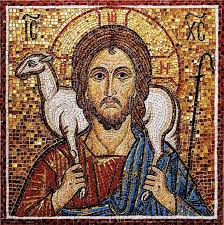Faces of Christ 1
- rhianprime

- Sep 8, 2020
- 3 min read
Faces of Christ 1
The creation stories of the Jewish and Christian faiths tell us that we are made in God’s image – we are physical and spiritual beings.
As God’s own son, Jesus of Nazareth was born into a Palestinian Jewish family and I imagine would have blended in with the local population – Jesus was a Palestinian Jew so would have probably had very dark brown eyes, dark hair and the Eastern Mediterranean skin tones we see today. Jesus was not white and he was not black.
If you watched tv during the 70s you may well have seen Franco Zefreli’s Jesus of Nazareth with our very own Robert Powell playing Jesus.

Around the world in different Christian denominations the faithful often use art as a help during prayer and there is of course a very deep spiritual use of icons in the eastern church of Russia,
Romania, Greece and so on. Not to be confused with the worship of idols, works of art depicting the gospel message or scenes from old testament scripture are used as a focus for prayer.

Different cultures and countries see Jesus of Nazareth in different ways. The idea of what Jesus looks like within the African nations or in East Asia is very different to the idea of what Jesus looks like within the South Americas or Northern Europe.
Different parts of the world see Jesus in the context of their own culture and environment or their own politics.
While I was having a bit of a sort out during the lock-down, I came across a resource called The Christ We Share and I thought we could have a look at some of the ways in which Jesus is depicted throughout the world.
Some of the oldest images of Jesus depict him as the Good Shepherd usually with a lamb slung across his shoulders which obviously is an image straight out of scripture.
So let’s have a look at some images of Jesus which will perhaps be unfamiliar – uncomfortable even.
The first is a wanted poster from Latin America. I don’t know how your Spanish is but the gist of the poster I think is that Jesus Christ is wanted for subversive ideas - standing with the poor and oppressed, is also known as Prince of Peace, Saviour of the World, Son of God. The reward (30 moedas) refers to the 30 pieces of silver given to Judas Iscariot for the betrayal of his friend.

The second is the Peruvian Crucifix – not a comfortable image. The artwork is in wood and clay by the Peruvian artist Ediberto Merida and depicts Jesus as the outcast, one who is difficult to love perhaps because they look a bit different, or have a lifestyle which is very different from our own.

This image was used on the cover of Gustavo Gutierrez’s book ‘A Theology of Liberation’.
In the South American countries (Latin America )liberation theology demands that Christians make a radical response to scripture and our relationship with God and one another on behalf of the desperately poor and very oppressed – if we say we know God, then we must not only stand with the poor and oppressed but act on their behalf - challenging social structures which may be unjust. Christ as the liberator gives dignity, forgiveness and above all love – God is in the midst of everything, particularly deprived communities.
Next time we will look at some images from another part of the world.
In the meantime, here's some music from Sweden



That was thought provoking! As we are a worldwide faith everyone will have a different image. X